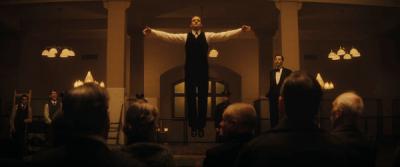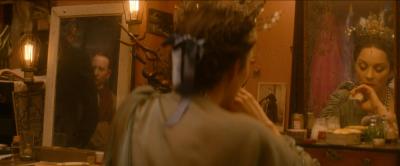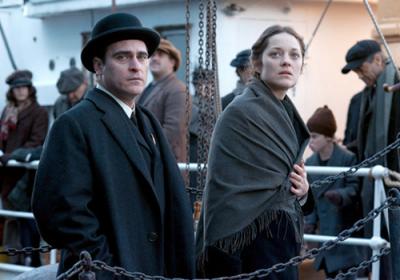By: debbie lynn elias
Writer/Director James Gray’s latest film, THE IMMIGRANT, is one not to be missed and, quite honestly, is the best work of his career thus far and will be difficult to top. Steeped in the rich immigration history of America in the early 20th Century, THE IMMIGRANT is set in 1921 New York where it revolves around the story of a young Polish Catholic immigrant named Ewa Cybulski, as she tries to navigate the treacherous waters filled with corrupt officials, hustlers and hookers, social taboos, cultural differences, over-crowded tenements and everyone trying to make a buck to stay alive in this “land of opportunity.” As part of Ewa’s tale, we meet Bruno, a vicious wolf in not so lily white sheep’s clothing, a charming and kind magician named Orlando, plus a cast of characters who make up this melting pot she desperately wants to call “home.”
Starring Marion Cotillard, Joaquin Phoenix and Jeremy Renner as Ewa, Bruno and Orlando/Emil, respectively, there’s a haunting mournful beauty to THE IMMIGRANT that breathes life into the ghosts of the past, at times romanticizing, at times brutalizing, but always living.
I spoke with James Gray in this one-on-one interview as he talked about his own genealogy and stories of his grandparents that served as the basis for this story and then melding same with extensive research and historical fact in order to pay respectful homage to history and to the millions of souls that passed through the halls of Ellis Island looking for hope, opportunity and love.

James, this is a film everyone should see as not only is it a beautiful human story, but it’s a great historical story that 90% of the people in this country can probably relate to. Much of it is a touchstone to many of our own pasts.
I’m gonna tell you a number which you may not know, which I did not know, which flabbergasted me, which is that 40% of the American population has at least one direct descendant that came through Ellis Island between 1900 and 1924 which is the period between that building and that hall and all [those events]. That is a staggering number. That’s like 140,000,000 people or something like that, that have a connection to that island. The history of it is very textured, nuanced and sometimes very dark, but also has possibilities. How do you ask for dramatic purposes anymore than that?
I can’t believe that no one has told a story like this until you. I know that your own personal background and family history inspired THE IMMIGRANT and I was particularly affected by it as my grandparents were immigrants from Germany, however, they came through Boston and were more privileged than most on their entry to this country.
This is also something I never knew but you probably do, sounds like you definitely knew it, that first class passengers didn’t go to Ellis Island. That was the steerage people, the people who were in big trouble basically. Most of them did not get turned away. In fact, the United States outright rejected only 2%. There were about 30% who wound up getting delayed for a few days or a few weeks, maybe put in the infirmary, but most people did wind up getting into the country one way or another. Which is why they closed the place basically for all intents and purposes in 1924. The island itself was closed in 1954, but when all these quotas went up in ‘24, they said, “You’re letting too many people in. What are you doing!” I became weirdly like an expert on Ellis Island.

I’m fascinated by your knowledge on it! That’s one of the things that is so appreciated with the film. You’re shooting within these actual halls where the immigrants passed through; not the pretty visitor’s center that tourists normally see.
That’s right. We built one thing. We had to build the cell that Ewa is in. It’s an exact replica, basically, of the ones that are in there, but we couldn’t shoot in the ones that are there now because they’re glassed off. They’re basically preserved. What we did was we just copied it exactly, that place where she’s put for the night. But you are quite right. We did shoot in the great hall and in a couple of hallways there. The thing that one doesn’t realize is that in some respects they treated the immigrant population in a way that’s better than we do now. I did not invent the concert with “Caruso Sings”. That’s based on actual history. And that’s remarkable. They had concerts at night for the people who were there, with the best entertainers of the day. And that’s amazing to me.
In your research, and somewhere in the recesses of my mind I recall stumbling across this myself, did you find that when immigrants came into the country, the government wanted to put America’s best foot forward so they would have “A” list entertainers and they would feed the people, they would entertain them, but also, it served as a transitory mechanism for what these individuals were missing from home?
You’re right. That’s right. I’ve not talked to anybody who knows that until you. You are so right. And I learned it only by doing the research. The very building that they made, that beautiful Beaux Arts building which they built in 1900, started in 1897. [It was] the first building that was on [the island]. That was built in 1892 and was this wooden dumpy looking place and it burned down in 1897. When they decided to rebuild it they said, “Okay, well we’re gonna build something that is truly magnificent, that says to the world, ‘When you come here, look at what you might be able to do!’ So the space itself is that room, what they call the Registry Room, this enormous magnificent space with the Gustavino tiling and all that stuff, it was really meant as a display of saying, ‘We hope you’re happy that you’re here. Look at what you’re gonna be able to do. Look at the magnificence of it.’

While I am enthralled that you brought that forth and captured that, you then also deliver the harsh realities of where Ewa and Bruno live, the tiny cramped little quarters, the little rooms and the dinginess and the seedier side of surviving.
The apartment that you’re talking about and it’s funny that you say “the cramped quarters” because yes, they were, but we built that on a sound stage. The first plan that we had was that we would shoot in an actual tenement. So I brought the crew to the Tenement Museum on Orchard Street . . . The history of it is incredible. This woman bought the place. She bought a row of buildings in 1980. She went in there and she realized that the buildings had been condemned in 1937 and the doors had basically been shut and that was it. The place was like a history lesson and she recognized that. And she made the Tenement Museum so when you walk in there, it’s a walking tour. The first tenement apartment is designed as though it were 1890, the second 1915 and the third 1937 when the building was condemned. You do this walking tour into the place and it’s just fantastic.

I took the crew – because I’m a crazy person – saying, “We all have to see this space. This is where Bruno and Ewa would be.” So we went in there, it’s on Orchard Street on the Lower East Side and the crew looked at me and said, “Are you kidding?” I said, “What do ya mean?” They said, “How are you gonna fit a camera in here?” 8 feet x 10 feet rooms for five people? The ceiling would be 8 feet. I mean, crazy. So what we did was, we rebuilt the tenement exactly except we would move a wall so that if we needed to put the camera somewhere we just moved the wall behind you or we could move stuff around. If I shot in the actual tenement there was no place for the camera to be. You realize what a struggle [for the residents] because those tenements were tiny, I mean tiny. They did “fast and loose” with the law. For example, there’s those weird windows that are in the middle of the apartment that divide one room from the other. So, you say to yourself, “Why do they have a window there?” Well, they were called “Tuberculosis Windows”. The law said that you have to have a window in the apartment because people would have tuberculosis and they’d want to cough or whatever. So they built windows in the apartment. It didn’t help anybody. It was a certainly a violation of the spirit of the law. They are very unique spaces. By the way, now they probably sell for like $2 million.
I’ve seen rooms like that used in films over the decades and it’s a beautiful decorative touch but I had no idea it had a purposeful origin. Fascinating piece of history. James, knowing that THE IMMIGRANT began based on stories told by your grandparents, how difficult or cathartic was it writing THE IMMIGRANT and bringing it to life?
I think it was a strange thing because what I did was I took all of the stories of my grandparents and essentially just put them in the movie. The whole thing that [Ewa] says in the church where she says [as he does a Polish accent], “The ship is dirty and we are all together likes animals”, all that stuff is basically just what my grandmother told me about the experience. Not understanding how to eat a banana? Biting it into the skin [was] from my grandmother. My grandfather talking about seeing parents getting their head chopped off by the soldiers [in Poland], and all that stuff, it all just wound up in the movie. In fact, my grandparents’ picture is in the movie. It’s in the locket that [Ewa] is looking at. That’s them. And, of course, the actress that plays the sister on the other side. The whole film was really meant as a kind of personal honorary. I have to say, at times I was filled with a bit of regret – they died in 1982 – not really taking the time to ask more questions. At the time I was 13 years old and I thought I was “too cool for school” and I wasn’t really paying attention to them. In fact, I’m ashamed to admit this, I didn’t really like them very much. I thought they were squares or something. I don’t know what my problem was. [laughing] But now it’s a real regret I have. It’s a central regret, not finding out more about that history. The rest of it, this whole idea of the corrupt Ellis Island official and then the Caruso concert, all of that came from the research on Ellis Island itself. What you might want to know, by the way, is that there is a research library in Ellis Island, in the building. It’s called the Bob Hope Memorial Library and they have unbelievable resources of photographs and research materials. It’s great.

We tried to make up nothing. We tried to base it all on something. Like the theatre. That theater where Bruno [Joaquin Phoenix] has his kind of really pathetic show, that’s based on a real theatre called The Hay Market. What would happen is the women would come out and they would sort of parade around in their costumes into the audience. It was a pretty small venue with these ridiculous shows where you would fantasize about, say, “The Queen of Arabia” [in his best ringmaster voice] and all this stuff , and Joaquin’s whole monologue later in the park where he’s saying, “Lady Astor!” or whatever, that’s all from a Hooker’s Handbook that we found from 1915. So all that stuff we tried to base on real stuff as much as possible.
Your visual palette adds so much along with the performances. Marion Cotillard is beyond reproach as Ewa, as is Jeremy Renner who adds this beautiful lightness to the structure as Orlando/Emil. But the visual palette that you and cinematographer Darius Khondji developed is mesmerizing. It’s as if each frame is dipped in a teabag of naturalism and reels us in, takes us back. “We are there” as Walter Cronkite would say. How did you go about developing this visual bandwidth?
Yea, [Darius Khondji] is pretty great. The first thing we did was we started reading about the area. What you learn is that the amount of coal and wood that was burned into the atmosphere would just shock you. The air was incredibly dirty and dense with particulate and you realize when you read that that the sun didn’t really make its appearance. Probably by 1923 or ‘21 they were rigged with electricity, probably right after WWI they started to get electricity, but they almost exclusively still relied on gaslight and gaslight gives off a kind of yellow ochre or burnished yellow kind of ochre hue. So those two ideas, those two notions, the one was the pollution in the air, the other was the ochre look of a gaslight, were the first two big steps we took in establishing the color scheme of the movie. Then we looked at these things called “autochromes” which are these color photographs from 1905, 1910. They’re not actually color film stock. What they are is they are black and white photos where they are printed on panes of glass and then a different dye is applied to the panes of glass so that when they’re married, the photo looks like color. It’s sort of a fake color photograph. We took those and tried to use those as a visual reference. Then, of course, the painters from the period, which would be the school of painters called “The Ashcan School” – Everett Shinn, William Glackens, John Sloan, George Bellos. Edward Hopper was one of them but he was a little bit later. He came into his own only in the 40’s really. We didn’t look at him too much. We looked at these other guys. They always painted a sort of New York urban life in a very authentic way. So these were the core principles we used to establish the look of the film.

Something else that you and Darius also did that I found particularly emotionally metaphoric is that because everything is so claustrophobic, especially in the apartments, whenever you have Jeremy Renner’s Orlando/Emil and Marion Cotillard’s Ewa together, the camera slowly widens out, metaphorically giving Ewa some breathing room from under the oppression of Phoenix’s Bruno. That is captivating to watch. Was that purposely designed going int the shoot or did that develop as you were filming?
We talked about that. [Emil] is the one shred of hope in the film for Ewa and it’s a big deal. When he gives her the rose and of course then later in the apartment itself, we kind of changed the color scheme and sort of lightened it up a bit. Then also on the stage, we had the curtain be this kind of curtain with stars as opposed to the other backdrops to indicate or imply endless opportunity. [Emil] talks about California and the sun is always shining there. There’s a kind of a hope for her and that the visual aspect would embrace this idea, that was of course there from the very beginning.
It was magical to see that. As I was watching, I could feel my own spirit being lifted with hers every time you’d have the two of them together. On the flip side, every time you’d then put Phoenix’s Bruno with her, the camera would come in even tighter, the palette would get a little darker. It was so fluid, so emotionally palpable.
Oh, that’s terrific. I’m so happy you feel this way. It seems like you understood the goddamn thing completely! It’s thrilling.

I was mesmerized watching the film. Fixated emotionally and visually. A fully sensory experience. Given the very personal nature of this story, what did you take away from this experience of bringing THE IMMIGRANT to life, or learn about yourself in the process?
[long hesitation] That no one is to be looked down upon. No one is beneath us. No one is not worthy of love. It’s an important idea, I think. Everybody can change. Everybody can be redeemed, even if you think they can’t. It’s important for yourself as well as for others because you have to forgive yourself of the things you’ve done wrong in your life. That’s what it means to me. That’s what motivated me in the film and what I still hold on to.
#
5/4/14











